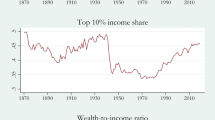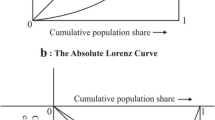Abstract
This paper provides measures of short and long-run inequalities as well as income stability among households with male heads using the panel study of income dynamics for the period 1969–1981. It is found that short-run inequalities have been increasing over the time period examined. Moreover, some fluctuations around this increasing trend are of a transitory nature and appear to be smooth over time. Long-run measures are less subject to fluctuations and provide a better measure of inequality. They show a decrease in inequality in the early periods but increases after the mid-1970's. Several aggregator functions are used to compute “permanent income” variables for the long-run measures of inequality and stability. The measures are decomposed to reflect differences in age, education, and race. They are decomposed also into groups which are free of such group characteristics. Education has the most important influence on inequality. Stability profiles indicate, furthermore, most of the reduction in inequality in the early periods has been within particular groups. Reductions across groups are minimal.
Similar content being viewed by others
References
Atkinson AB (1970) On the Measurement of Inequality. Journal of Economic Theory II:244–263
Blinder AS, Gordon RH, Wise DE (1980) Reconsidering the Work Disincentive Effects of Social Security. National Tax Journal 33
Burtless G, Moffitt RA (1984) The Effect of Social Security Benefits on Labor Supply of the Aged. In: Aaron and Burtless (eds) Retirement and Economic Behavior, Brookings Institution
Chiswick B (1974) Income Inequality. National Bureau of Economic Research, New York
Cowell FA, Kuga K (1981) Inequality Measurement: An Axiomatic Approach. European Economic Review 15:287–305
Cowell FA, Mehta F (1982) The Estimation of Interpolation of Inequality Measures. Review of Economics Studies XLIX:273–290
Dooley MD, Gottschalk P (1984) Earnings Inequality Among Males in the United States: Trends and the Effect of Labor Force Growth. Journal of Political Economy (92)1:59–84
Foster JE (1983) An Axiomatic Characterization of Theil Measure of Income Inequality. Journal of Economic Theory 31:105–121
Freeman RB (1979) The Effect of Demographic Factors on Age-Earnings Profiles. Journal of Human Resources 14:289–318
Henle P, Ryascavage P (1980) The Distribution of Earned Income Among Men and Women, 1958–1977. Monthly Labor Review
Kakwani N (1976) On the Estimation of Income Inequality Measures from Grouped Observation. Review of Economics Studies 43:483–492
Kakwani N (1984) The Relative Deprivation Curve and its Applications. Journal of Business and Economic Statistics 2:384–405
Maasoumi E (1986) The Measurement and Decomposition of Multi-Dimensional Inequality. Econometrica 54:991–997
Maasoumi E, Zandvakili S (1990) Generalized Entropy Measures of Mobility for Different Sexes and Income Levels. Journal of Econometrics (43)2:121–133
Mincer JA (1974) Schooling, Experience, and Earnings, New York: Columbia University Press
Parsons DO (1980) The Decline in the Male Labor Force Participation. Journal of Political Economy 117–134
Plotnick RD (1982) Trends in Male Earnings Inequality. Southern Economic Journal January 48:724–732
Rosen S (1984) Comment of Kakwani (1984)
Shorrocks AF (1978) Income Inequality and Income Mobility. Journal of Economics Theory 19:376–393
Smith JP, Welch F (1979) Inequality: Race Differences in the distribution of Earnings. International Economics Review (20)2:515–526
Theil H (1976) Economics and Information Theory. Amsterdam: North-Holland
Welch F (1979) Effects of Cohort Size on Earnings: The Baby Boom Babies' Financial Bust. Journal of Political Economy 87:S65-S97
Author information
Authors and Affiliations
Additional information
Helpful comments from Esfandiar Maasoumi, Joseph Craycraft, Kenneth Koford and two referees are acknowledged. The usual caveat as to remaining errors applies.
Rights and permissions
About this article
Cite this article
Zandvakili, S. Generalized entropy measures of long-run inequality and stability among male headed households. Empirical Economics 17, 565–581 (1992). https://doi.org/10.1007/BF01205396
Received:
Revised:
Issue Date:
DOI: https://doi.org/10.1007/BF01205396




